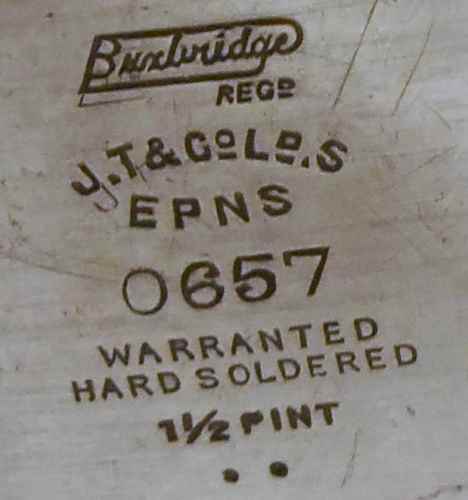|
EPNS Electro Plated Nickel Silver
EPBM Electro Plated Britannia Metal
Modern electroplating was invented by Italian chemist Luigi V. Brugnatelli in 1805. Brugnatelli used his
colleague Alessandro Volta's invention of five years earlier, the voltaic pile, to facilitate the first
electro-deposition. Unfortunately, Brugnatelli's inventions were repressed by the French Academy of Sciences
and did not become used in general industry for the following thirty years.
Silver plate or electroplate is formed when a thin layer of pure or sterling silver is deposited
electrolytically on the surface of a base metal.
By 1839, scientists in Britain and Russia had independently devised metal deposition processes similar to
Brugnatelli's for the copper electroplating of printing press plates.
Soon after, John Wright of Birmingham, England, discovered that potassium cyanide was a suitable
electrolyte for gold and silver electroplating.
Wright's associates, George Elkington and Henry Elkington were awarded the first patents for electroplating
in 1840. These two then founded the electroplating industry in Birmingham (England) from where it spread
around the world. |

Many base metals could be used to fashion the objects and two or more different materials were often used for the various components. Thus the properties of each metal were fully exploited to their best advantage.
Various alloys were used as base metal for electro-deposition of silver.
The alloy of copper, nickel and zinc is known under many names as German silver, Argentan, Albata, Alpacca, Electrum. They have slightly different formulations but their composition varies from 50% - 60% copper, 20% - 25% nickel and 20% - 25% zinc.
The result is a hard and durable material and its color (a very pale yellow/white) didn't compromise the aspect of the object when the plating wore off under the action of over-zealous cleaners.
In the UK and in USA silverware using this alloy were marked EPNS (or E.P.N.S), adopting the initials of Electro Plated Nickel Silver.
Another material was an alloy based on tin and developed in various European countries. It was known under different names as Britannia Metal, Kayserzinn, Orivit, etc. having, also in this case, slightly different proportions of metals.
The Britannia Metal used in the UK and in the USA had 93% tin, 5% antimony and 2% copper and was marked EPBM (or E.P.B.M) for Electro Plated Britannia Metal.
Sometimes was used the mark "EP on BM" or the abbreviated form "BP" (Britannia Plate).
EPBM was often used for cheaper wares, as this alloy is rather soft and malleable, which meant that objects could be easily dented. Nevertheless it was often used for hollowware as tea and coffee pots as its grey color was not too evident when plating was damaged.
Anyway EPNS was preferred for cutlery and other objects which were subject to heavy use.
|

www.silvercollection.it |
This is a page of 'The What is? Silver Dictionary' of A Small Collection of
Antique Silver and Objects of vertu, a 1500 pages richly illustrated website offering all you need to know about
antique silver, sterling silver, silverplate, Sheffield plate, electroplate silver,
silverware, flatware, tea services and tea complements, marks and hallmarks, articles,
books, auction catalogs, famous silversmiths (Tiffany, Gorham, Jensen, Elkington),
history, oddities ...
HOME - SITE MAP - SILVER DICTIONARY - COOKIES CONSENT AND PRIVACY |
| |